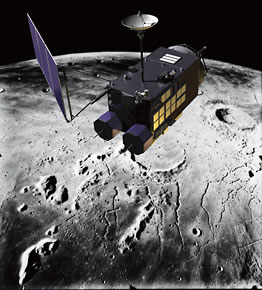TOP > Report & Column > The Forefront of Space Science > 2004 > Shall we return to the Moon ?
![]()

Introduction When I was a child, I thought, everyone would be able to go to the Moon in the 21st century if they so wanted. I also imagined that we would be living in an age with a permanent base on the Moon, where people could look out at the boundless ocean of space and plan missions to tackle the profound mysteries of space. The reality of 2004, however, is different from what I envisioned. Mankind has not been able to return to the Moon, let alone visit other planets. Under the circumstances, Japan is steadily pursuing projects to return to the Moon. They are LUNAR-A (refer to the article by Tanaka in the ISAS News, August 2002 edition) and SELENE (SELenological and ENgineering Explorer) that I participated in (see the front cover). The objectives of SELENE are to collect science data: to elucidate the origin and evolution of the Moon; on outer space covering the Earth and the Moon; and for a feasibility study on lunar use in the future. SELENE is an explorer orbiting the lunar polar orbit, planned to be launched by a 2t-class H-IIA rocket. Carrying 15 mission instruments, it will collect far better data on the entire Moon than those obtained in the past over a one-year period. The SELENE project is now in the final stage toward launch in FY2006. This article explains what we expect from the lunar exploration, taking into account possible approaches using SELENE's data. The Moon, key to elucidating mysteries of solid planets The Moon is the celestial body nearest to the Earth. The Earth, however, has an atmosphere and oceans, and is full of life. The Moon, however, is a “dead” planet covered with craters, its own internal activity finished. Why have these differences emerged? The quest for the Moon's origin and evolution is essential in terms of understanding the Earth. For example, with the SELENE investigation of the Moon's final internal-evolution processes, we will try to understand the evolutionary process of solid planets. The Moon completed its own internal activities three billion years ago, but it is likely that some eruptions continued afterward. Since these “young” lunar areas, dating from three billion years ago to the present, were formed by eruptions in the final stages of lunar evolution, the number of eruptions is small and, accordingly, the areas are narrow. For a narrow area, we cannot use a method based on the quantitative density of craters to estimate the formed age. Another method must be employed. We can estimate the formed age by identifying the degree of collapse in craters. Craters formed on the lunar surface are gradually corrupted by tiny meteorites. By investigating the degree of collapse of 100m-diameter-plus craters, it is possible to estimate the date of crater formation from three billion years ago to the present, including the formed age of the surrounding area. The image resolution obtained so far for the largest lunar surface is a few 100m at best, and under 10m for around 20% of the eastern half of the lunar equatorial region. SELENE will carry stereovision “Terrain Camera” (see Fig. 1) with high-resolution capability of 10m in the horizontal direction. It is expected that the cameras will be able to locate “young” areas. SELENE also carries “Multi-band Imager” (see Fig.1), with five bands of visual wavelengths with a capability of 20m-horizontal resolution and one camera with four bands of near-infrared wavelengths with a capability of 60m-horizontal resolution, and a Spectral Profiler (a continuous spectrometer with a few-nm spectroscopic capability). These will help us identify what materials are there, and how they lie within the area. It is expected that this investigation will enable us to elucidate the figure of material differentiation in the final phase of the Moon's internal activity. The outcome of the research must, eventually, contribute to the elucidation of thermal history in solid planets including the Earth.
|
||||||||






